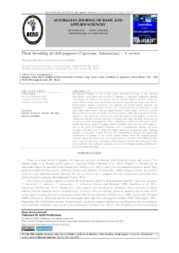Plant breeding of chili peppers (Capsicum, Solanaceae) - A review.
Plant breeding of chili peppers (Capsicum, Solanaceae) - A review.
Author(s): PADILHA, H. K. M.; BARBIERI, R. L.
Summary: Peppers is one of the oldest domesticated crops in the Western Hemisphere. Long before the arrival of Columbus in Americas, indigenous already used peppers as food, as war artifacts and in religious rituals. Capsicum genus has perfect flowers where male and female reproductive structures are in the same flower. Domesticated peppers (Capsicum) are diploid and predominantly perform self pollination. In comparison level, the size of C. annuum genome is around three to four times larger than tomato. The hot pepper genome shared highly conserved syntenic blocks with the genome of tomato, its closest relative within the Solanaceae Family. Objective: This article has reviewed the plant breeding of chili peppers (Capsicum, Solanaceae). Results: Genetic diversity of peppers are large, allowing alternatives to several new gene rearrangements. Thus, methodology employed will depend of the feature that aims to achieve in pepper genetic breeding. Search for the hottest pepper is one of the goals in breeding programs, even as productivity, disease and pests resistance and fruit traits. Conclusion: Pepper fruits have nutricional value, bringing benefits to consumer’s health. This fact has contributed to increase the market and consumption of peppers in the world. Current studies about the complete pepper genome sequencing allows new associations between genomics and important plant traits. Usage of molecular technologies will continue to advance becoming an essential tool, combined with traditional selections and crosses techniques already established in Capsicum genetic breeding.
Publication year: 2016
Types of publication: Journal article
Keywords: Genetic diversity, Genetic variability, genetic resources
Observation
Some of Embrapa's publications are published as ePub files. To read them, use or download one of the following free software options to your computer or mobile device. Android: Google Play Books; IOS: iBooks; Windows and Linux: Calibre.
Access other publications
Access the Agricultural Research Database (BDPA) to consult Embrapa's full library collection and records.
Visit Embrapa Bookstore to purchase books and other publications sold by Embrapa.

